Who Killed Themselves Because of the Degenerate Art Exhibition
The Nazi art hoard that shocked the globe
(Image credit:
Bundeskunsthalle
)
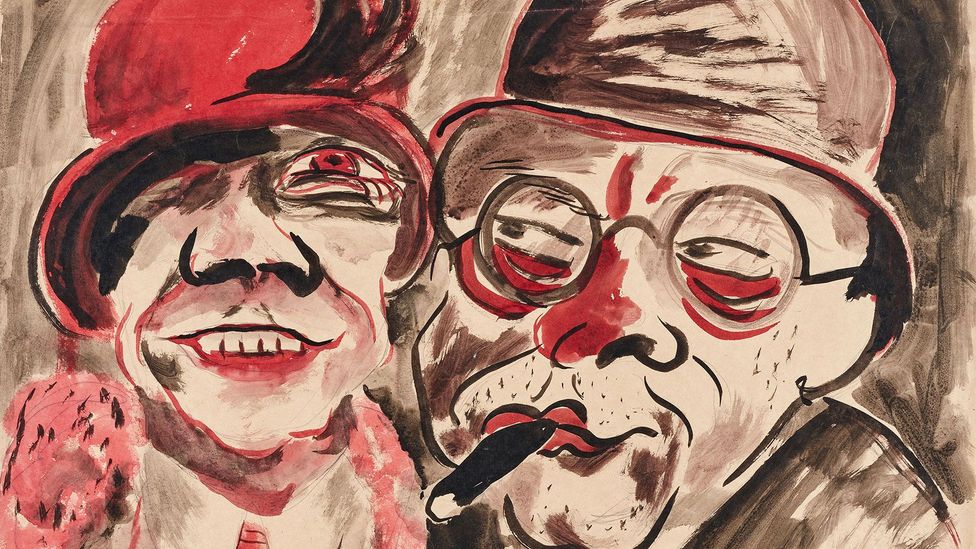
2 new exhibitions look at how Hildebrand Gurlitt was able to exploit the Nazi system in order to amass a vast collection of work past 'degenerate artists' and Jewish collectors, writes Cath Pound.
T
The discovery of nigh 1500 artworks including examples by Picasso, Munch, Matisse, Kirchner and Klee in the properties of Cornelius Gurlitt in 2012 stunned the art world. The 'Munich Art Hoard', every bit it became known, was immediately suspected of existence looted during the Nazi era, not least because Cornelius'southward father was the celebrated art historian and dealer, Hildebrand Gurlitt – a human who it transpires was prepared to exploit every aspect of Nazi policy to personally enrich himself, despite his Jewish heritage.
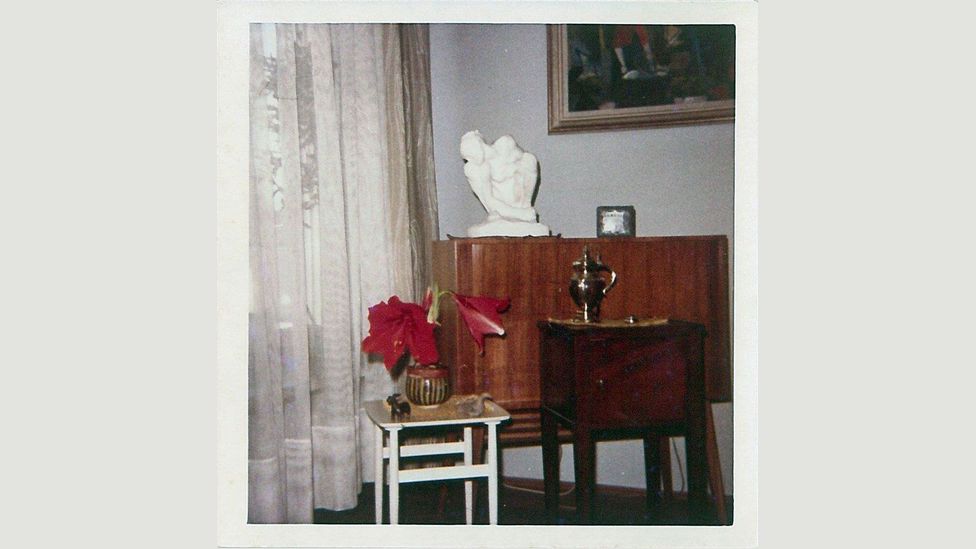
In 2012, nearly 1500 artworks were found in the properties of Cornelius Gurlitt, in Munich, Germany (Credit: Bundeskunsthalle Bonn)
Peradventure the publicity pricked Cornelius'due south conscience, for on his expiry in 2014 he controversially left the hoard to the Kunstmuseum in Bern, stipulating that the provenance of the works exist examined and any looted art returned to the heirs of the original owners.
The first exhibitions to analyse the collection, jointly organised between the Kunstmuseum in Bern and the Bundeskunsthalle in Bonn, are not fine art historical in whatsoever conventional sense. Instead they focus on the circumstances which allowed Hildebrand Gurlitt to build his collection; the persecution of 'degenerate artists' and Jewish collectors and dealers under the Nazi authorities.
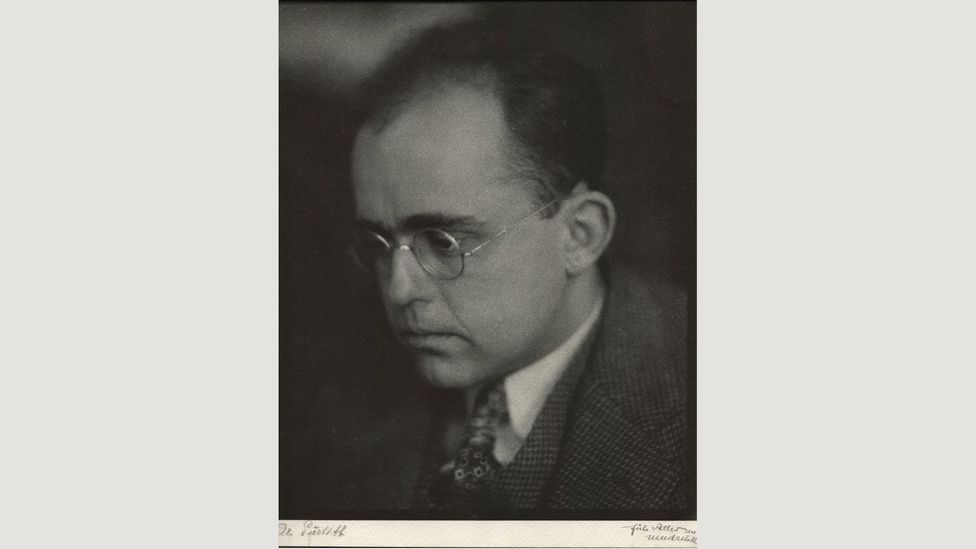
Cornelius's father was the celebrated fine art historian and dealer Hildebrand (Credit: Alamy)
Hildebrand Gurlitt's taste in art ran counter to the men who would become his masters and twice cost him his job, first at the Zwickau museum where his exhibitions of Die Brücke artists such as Erich Heckel, Karl Schmidt-Rottluff and Emil Nolde vicious foul of the Militant League for German Culture, and then at the Kunstverein in Hamburg where the ascent of the National Socialists meant that anyone seen to promote 'degenerate art' came under pressure, and he was forced to resign in 1933.
Classified as a quarter Jew nether the Reich Citizenship Laws because of his Jewish grandmother, Gurlitt was no longer able to piece of work for the country. Relying on the excellent contacts he had made as a museum director he ready himself up equally a dealer, taking the precaution of registering the business under the name of his Aryan wife Helene.
Here he was, cautiously, still able to exhibit artists he favoured such as those of Die Brücke and the later Expressionists including Otto Dix, George Grosz and Max Beckmann.
Taking advantage
He soon became very successful – but it is clear that his success relied largely on the exploitation of other Jewish dealers and collectors. Membership of The Reich Chamber of Fine Arts became compulsory for dealers and from 1935 Jews were systematically excluded, forcing them to liquidate their collections and allowing dealers similar Gurlitt to benefit from lower-than-market prices every bit well as the increasing lack of contest.
"When we speak about looting and art theft it normally wasn't robbing: it was a more than, permit's say subtle, way of getting these works," says Rein Wolfs, Director of the Bundeskunsthalle in Bonn. "It was mostly past suppression or by putting then much pressure on somebody that he had to sell."
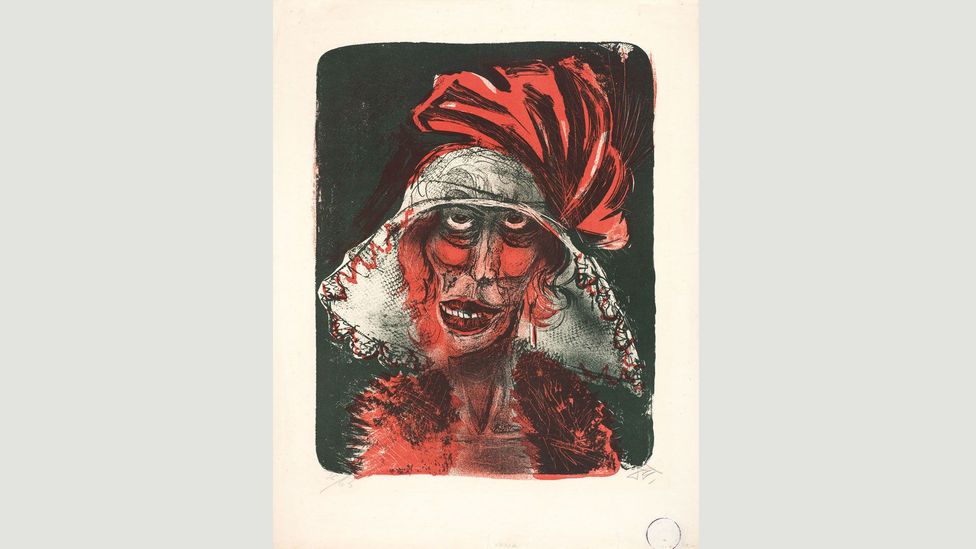
Gurlitt favoured Dice Brücke artists and the subsequently Expressionists, including Otto Dix, whose Leonie (1923) is pictured (Credit: Kunstmuseum Bern)
Gurlitt took advantage of the vulnerable position of Jewish collectors forced to sell work to finance punitive Nazi fines or the cost of emigration. I such example is the Adolph von Menzel drawings bought from the Cohen family in the mid 1930s, most likely to finance a flight to the United states of america. He paid between 120 and 200 Reichsmarks per cartoon. "Which was only a fraction of what they were worth at the time," says Wolfs.
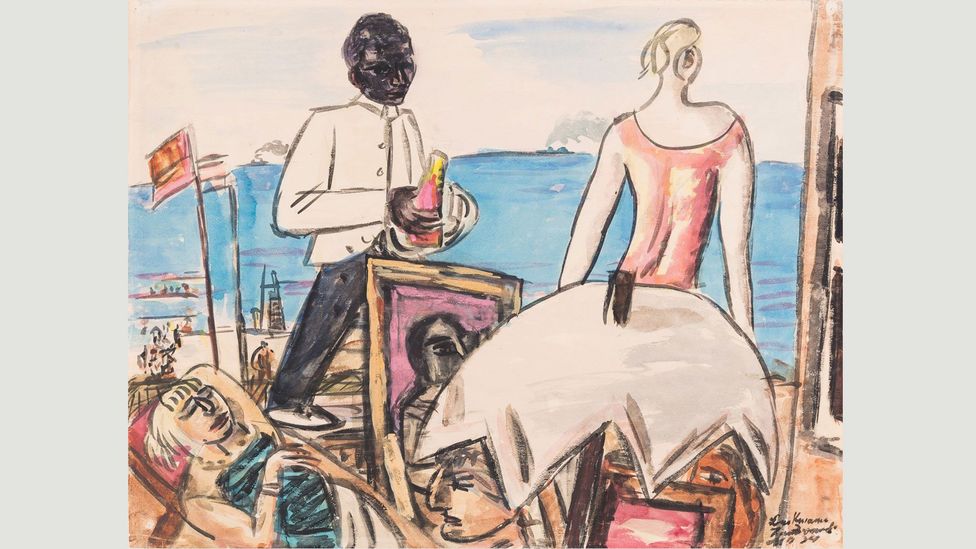
Max Beckmann was also amid the artists whose work Gurlitt appreciated - Zandvoort Strandcafe (1934) pictured (Credit: Kunstmuseum Bern)
The artists Gurlitt favoured were also suffering due to the virulent entrada against 'degenerate art.' Max Beckmann was accused of being a 'cultural Bolshevik' and dismissed from his education mail, every bit was Otto Dix. Despite publically declaring his allegiance to Hitler and the Nazis, Heckel was also deemed 'degenerate'.
Paul Klee was removed from his teaching post for existence Jewish and therefore automatically 'degenerate'. He fled to his native Switzerland only suffered financially from the loss of clients. He had a brief upturn in fortune thank you to new markets in the Usa, but died in 1940. Ernst Ludwig Kirchner was already ensconced in Switzerland but, suffering from hallucinations and fearing the Germans would come for him, he destroyed all his wood blocks, sculptures and personal documents earlier killing himself in 1938.
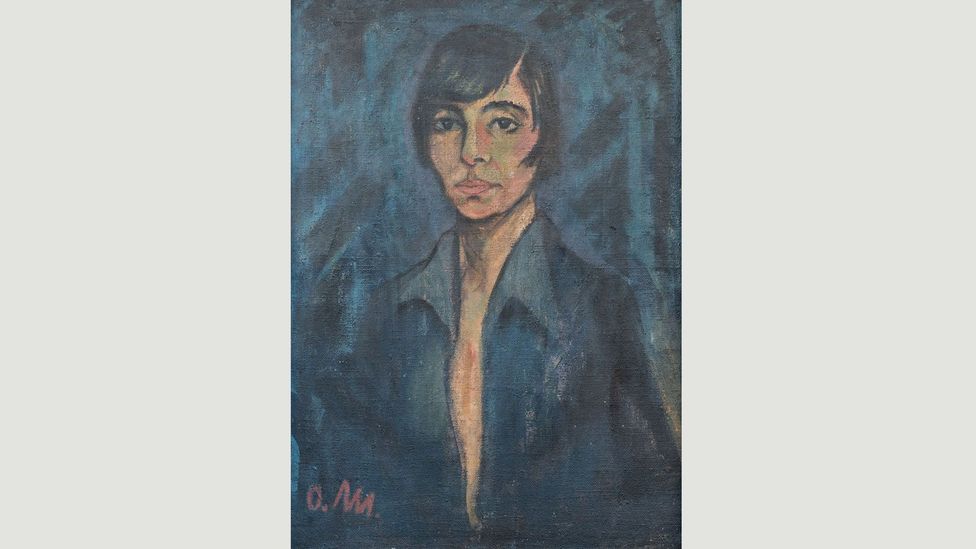
Otto Mueller's Bildnis Maschka Mueller, 1925 is featured in the Kunstmuseum's exhibition (Credit: Kunstmuseum Bern)
These artists had their works removed from German museums, with many catastrophe upwards in the notorious Degenerate Fine art exhibition of 1937. Shortly after, the Nazis decided to turn a profit from the art they despised by selling it to strange collectors, with the intention of destroying all that went unsold. The 1939 sale at the Fischer Galleries in Lucerne attracted worldwide attention but nigh of the works were sold individually by iv collectors, one of whom was Hildebrand Gurlitt.
'A sense of guilt'
He cannot have been unaware of the suffering effectually him so why offer his services to a regime which had twice toll him his chore? "He was very pragmatic of course," says Wolfs, "but I still say yous can be pragmatic to a certain extent, but after that you have to be aware that what y'all're doing is ethically not right."
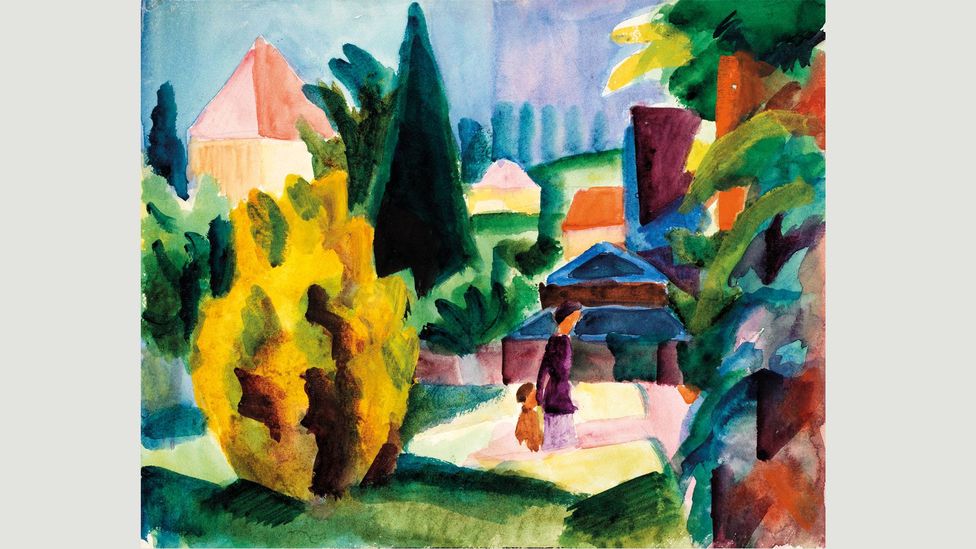
The German Expressionist painter August Macke's Im Schlossgarten von Oberhofen, 1914 is too featured (Credit: Kunstmuseum Bern)
If the sale of 'degenerate art' could be excused equally saving work which would otherwise take been destroyed, as indeed Gurlitt tried to practise after the war, exploiting the looted collections of occupied territories was where he moved "from morally muddy waters completely to the night side," says Nina Zimmer, Director of The Kunstmuseum in Bern.
When France fell, the Nazis lost little time in tracking down the greatest private collections to furnish Hitler's fantasy project of The Führermuseum in Linz. "They full-bodied on Jewish individual collections, amazing collections similar the Rothschilds," says Zimmer. Taking over these art treasures was, for them, "their biggest moral victory," she adds.
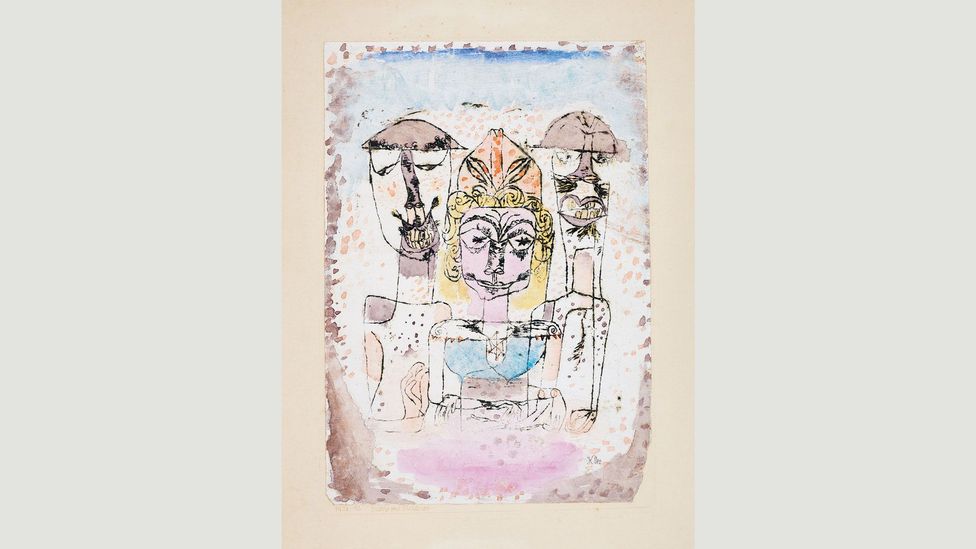
Paul Klee was removed from his pedagogy post for being Jewish and therefore automatically 'degenerate' - his Grieche und Barbaren, 1920 is pictured (Credit: Kunstmuseum Bern)
From 1943 Gurlitt was i of the privileged few given a committee to buy works for the Führermuseum. And it is clear that he also took the opportunity to expand his own drove. One of the near meaning finds in the Munich Art Hoard was Seated Woman by Matisse, a piece of work originally owned by the Jewish art dealer Paul Rosenberg, who had been forced to flee Paris. The work was returned to his heirs in 2015.
Although his collection was initially confiscated by the Allies afterward the war, Gurlitt was successfully able to fence that he had been a victim of Nazi policies and had in fact managed to save many artworks. With a few exceptions, nigh were returned to him and he went on to become Manager of the Kunstverein in Düsseldorf.
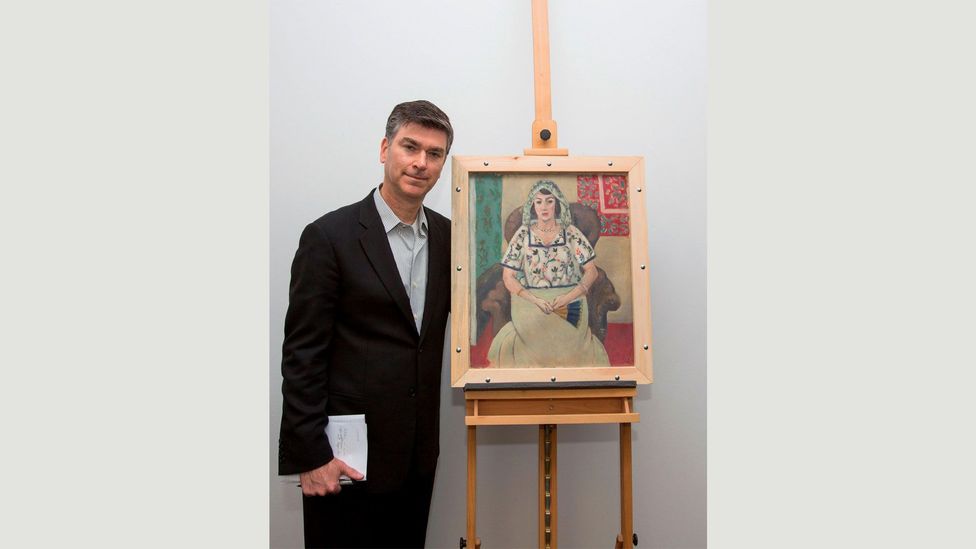
One of the most pregnant finds was Seated Adult female by Matisse – endemic by the Jewish art dealer Paul Rosenberg – seen here with a Rosenberg representative (Credit: Alamy)
"At the time there were no questions. Earlier the internet information technology was much easier to lie and get abroad with it," says Zimmer. In 1953 he even loaned some of his works to the High german Art Masterpieces of the 20th Century exhibition in Lucerne, organised every bit counterpoint to the 1939 sale, where he was hailed every bit a saviour of avant-garde art.
And he could well have been the legal owner of those detail works. The Allies never repealed the laws set in place by the Nazis to allow them to strip the museums, deciding that the Germans were, in effect, robbing themselves.
The works taken from Jewish collectors are a very different affair, equally perchance Cornelius himself finally realised when making his will. It took far too long, but somewhen he seems to have felt a sense of guilt, and a responsibility, that Hildebrand Gurlitt never did.
If you would like to comment on this story or anything else yous accept seen on BBC Culture, head over to our Facebook folio or message us on Twitter .
And if yous liked this story, sign upwardly for the weekly bbc.com features newsletter , called "If You Only Read 6 Things This Week". A handpicked selection of stories from BBC Futurity, Civilisation, Capital and Travel, delivered to your inbox every Fri.
Source: https://www.bbc.com/culture/article/20171212-the-nazi-art-hoard-that-shocked-the-world
0 Response to "Who Killed Themselves Because of the Degenerate Art Exhibition"
Postar um comentário